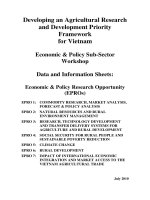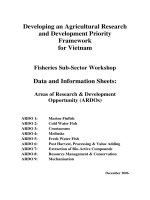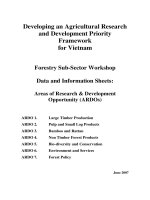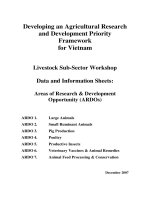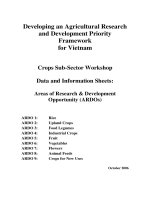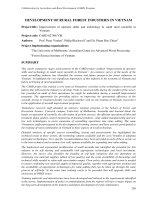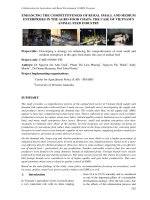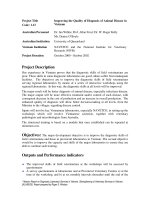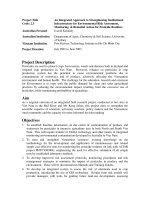Báo cáo nghiên cứu nông nghiệp " Developing an Agricultural Research and Development Priority Framework for Vietnam " pdf
Bạn đang xem bản rút gọn của tài liệu. Xem và tải ngay bản đầy đủ của tài liệu tại đây (348.98 KB, 89 trang )
Developing an Agricultural Research
and Development Priority
Framework
for Vietnam
Workshop
Economic & Policy Research
WORKBOOK
July 2010
2
WORKSHOP OBJECTIVES
Assess the national priorities for economic and policy research and
development in Vietnam
WORKING IN GROUPS
All participants will be seated in mixed pre-selected groups. The majority of work will
be in these groups. The composition of groups will be changed as needed throughout
the workshop.
There are some basic “rules” for working effectively in workshop groups:
recognise that each person’s opinion is valid
take responsibility
for contributing
for understanding
2:1 rule
criticise but after positive feedback
listen actively
use ‘and’ instead of ‘but’
express yourself concisely
keep to time
turn off mobile phones – use only during coffee and lunch breaks
For each workshop session:
make sure people are allotted the task of taking notes
watch the time
Economic and Policy Research Priorities for Vietnam
3
EXPECTATIONS OF WORKSHOP/PARTICIPANT
INTRODUCTION
[Purpose is to ensure participants know who is there, where they come from, what
skills are represented, and consolidate expectations of the workshop]
Group discussion
Each participant
Who am I – name, affiliation, responsibility, interest/experience
What I want to happen at this workshop
What I don’t want to happen at this workshop
[2 minutes per person]
Tables
Pool expectations
Decide on 3 cards per table for each of wants and don’t wants
Report back One person from each table to provide brief pen picture of the table
(2 min per table)
Facilitator collect, group, paste cards
[Reporting to be on Cards to enable visualisation of the output of each session and
typing of each session’s work for distribution to participants]
Economic and Policy Research Priorities for Vietnam
4
STRATEGIC CONTEXT FOR ECONOMIC & POLICY RESEARCH IN
VIETNAM
[Purpose is to develop a common understanding of the main issues facing the
agriculture economy and policy environment in Vietnam to provide the context for
priority setting]
Table Discussion
What are the major issues external (national and international) to the
agricultural economy and policy setting environment that have important
implications for the future
What are the major issues internal to the agriculture economy and policy setting
environment that have important implications for the future
Identify the issues and implications, recording issue and implication on different
coloured cards
Half tables consider external issues and half tables consider internal issues
NOTES
Economic and Policy Research Priorities for Vietnam
5
RESEARCH & DEVELOPMENT PRIORITIES METHODOLOGY
OUTLINE OF THE PRIORITY SETTING METHODOLOGY1
INTRODUCTION
The primary objective behind Research & Development (R&D2) priority assessment is to
determine the broad research programmes that will provide Vietnam with the greatest
return on investment in R & D provided by government and other major stakeholders.
Priority setting is the central issue of research and extension management. It is a complex
task. It must be done in a systematic framework able to allow the results to support open
and robust decision-making about research and extension resource allocation and
management. The highest priority R & D is that which has the highest economic, social
and environmental value to the nation.
Choices must be made about the Areas of Economic and Policy Research Opportunity
(EPRO) to support, and which not to support. If there are no established priorities, then
the choices made will be unlikely to produce results of maximum benefit to Vietnam. At
worst, the results will be irrelevant and provide no return for the public investment
involved. In addition the limited staff and resources available to undertake such research
and the high level of un-scheduled requests for urgent responses to policy issues and
advice from the Ministry and the Party, requires IPSARD to focus its longer term
substantive research in a very few areas.
is
as
ph
Em asis
ng ph
ro Em
St
ng
ro
St
d
it e
m
Li
EC
TI
V
IT
SE
L
IN
C
RE
A
SE
D
is
as
ph
m
eE
Y
iv
ct
le
Se
ATTRACTIVENESS
Figure 1: Use of Priorities to Assist in Selection of Research Programs/Projects
t
or
pp
Su
FEASIBILITY
1
CSIRO Australia has applied the basic model described here at corporate and division levels and it has been used in
more than 60 other research organisations in Asia, Australia and New Zealand, USA and Europe. The conceptual
analytic framework is based on the one published by the Industrial Research Institute, New York in 1986, viz: R N
Foster, L H Linden, R L Whiteley and A M Kantrow, Improving the return on R&D-I, in 'Measuring and Improving the
Performance and Return on R&D', IRI, New York (originally published in Research Management, January 1985).
2
Development includes technology development and transfer using transfer mechanisms including extension
Economic and Policy Research Priorities for Vietnam
6
In the past the research and development program is driven by MARD staff using an
allocative process. In the future MARD will fund research under an open and contestable
process without bias. The aim is to improve the efficiency and effectiveness of
investment into research and to develop a research environment that encourages a high
degree of innovation. Under this process MARD will clarify the priorities for research
investment and define the broad outcomes expected that investment. The research
providers will submit research proposals and budgets that will contribute to achievement
of these outcomes. In a “perfect world” those projects that offer the best value for money
will be supported.
There is a range of methodologies available for R & D priority setting. Selection of the
most appropriate methodology for Vietnam is driven by:
1. The need to use a consultation process that involves a large number and diverse
range of stakeholders;
2. The need to develop ownership of priorities amongst MARD and research
institute staff, farmers, exporters, processors and marketers.
3. The absence of detailed and reliable statistical data on production, profitability,
and markets and the absence of research on the impact of policies and on the key
drivers of new and more effective agricultural policies;
4. The need to move from R & D focussed on production and subsistence/food
security to R & D emphasising an empowering policy environment the generate
improved agriculture sustainability, profitability, quality, marketing and
commercial systems;
5. The need to use an objective process that evaluates the likely economic, social and
environmental benefits to Vietnam;
6. The capacity to undertake appropriate research.
An important principle is to implement the process and learn from experience, doing
what make sense rather than worrying about academic perfection.
THE METHODOLOGY
Specific principles about priority setting include:
Consider areas that are easily related to the benefits from research (the purpose
of the research) not research disciplines – in this case defined as Economic &
Policy Research Opportunities (EPRO)
These areas should be mutually exclusive and collectively exhaustive,
consistently based, forward looking and manageable in number
Linked to and consistent with the research financing the process
Criteria are independent
The criteria used should consider:
o The potential economic, environmental, social, institutional and
scientific benefits from successful research
o The context within which research products and services will be used
o The state of development of required research tools and techniques
and the health of appropriate disciplines
o The availability of research skills and infrastructure
Importantly, priorities are relative; the lower the priority of an area the
greater the selectivity in choosing projects within them, as illustrated in
Figure 1.
Economic and Policy Research Priorities for Vietnam
7
The model recommended for use in Vietnam is a five-step process.
1. Define broad Economic & Policy Research Opportunities (EPROs) at the sub-sector
level
2. Prioritise EPROs at the sub-sector level
3. From the results of the sub-sector prioritisation establish priorities at the sector level
(these may combine some of the sub-sector level priorities into a larger grouping.
4. Undertake Sector level research prioritisation
5. Prepare workshop reports and a National R&D Investment Portfolio and Policy
Statement
EPRO Definitions
In the case of the EPROs several workshops and iterations on the number and coverage of
EPROs were facilitated within IPSARD. Initially there were 17-18 broad EPROs but
these were reduced as more work and areas of duplication and areas outside the thematic
area of agriculture and rural development were eliminated.. From the results of these
workshops a sector set of EPROs was prepared and these are contained in this workbook
(Data Sheets) and in a second workbook where data and information has been analysed
according to the research priority setting framework (discussed below)..
EPROs were to be defined in terms of goal, scope and coverage. The goal describes the
results expected from all the research in the EPRO - e.g. for commodity research the goal
defined was “To develop the capacity for market analysis and forecast, to improve
competitiveness of major Vietnamese products in domestic and international markets
and to use that capacity as a basis for providing commodity policy advice, including
food security, to Government.”
EPRO Priorities
The model used to form Research priorities is relatively simple. It asks participants to
evaluate the overall merit of Research investment in each EPRO, in terms of
Attractiveness to Vietnam and its Feasibility in Vietnam. A scoring scheme is used to
compare and rank the EPROs. Scoring is an effective way to allow a group to take all
factors critical to the decision into account in a logical and open way. The relative scores
for each EPRO are developed in structured group discussions in terms of four
independent criteria. These are:
1. Market & Production Potential Benefits for Vietnam
2. Factors Working For & Against Achievement of Potentials
3. Potential Contribution of R & D to Development
4. R &D Capacity Within Vietnam
The relationship between these four criteria is shown in the assessment framework below.
Economic and Policy Research Priorities for Vietnam
8
The relative rankings and positions of the EPROs are important. They indicate the best
“areas” for research and/or extension investment. When the priority-setting group
represents researchers, extension workers and academics, farmers, politicians and the
agricultural industry and other stakeholders, the methodology ensures that the best
recommendations possible at the time are made.
An example of the outcome of the priority setting process
Figure 1. Plot of attractiveness versus feasibility for a hypothetical set of eight EPROs
showing their priority rating on the basis of their return to Vietnam.
RETURN FROM R&D FOR EACH AREA OF RESEARCH OPPORTUNITY
100
90
8
1
80
70
3
60
5
Attractiveness 50
40
6
7
30
4
20
10
2
0
0
10
20
30
40
50
60
70
80
90
100
Feasibility
In Figure 1, two EPROs (# 1 and # 8) score the highest for both attractiveness and feasibility.
They are located in the top right hand corner of the graph. They warrant strong research and
extension emphasis, and are the highest priority group of EPROs. Those located more towards
the centre of the graph (# 3, # 5, # 6 and # 7) warrant selective research and extension emphasis
and can be classed as moderate priority. The two with low scores for both attractiveness and
feasibility (# 2 and # 4) justify only limited support and have a low priority.
EPROs # 3 and # 5 have similar attractiveness scores, but EPRO # 5 scores higher on feasibility.
In this hypothetical example the lower feasibility score for EPRO # 3 occurs because the skills
available to carry out the research and or extension are considered to be inadequate. When the
necessary skills are acquired, the two EPROs would otherwise be equal claimants for research
Economic and Policy Research Priorities for Vietnam
9
resources. Attractiveness is determined by factors other than research and extension, such as
markets, profits, employment, social and cultural benefits, so while EPROs # 5 and # 7 have
similar feasibility scores, # 5 is more attractive, and could be allocated more resources for
research and extension.
Economic and Policy Research Priorities for Vietnam
10
AREAS OF RESEARCH AND DEVELOPMENT OPPORTUNITY
(EPRO)
A Preparation workshop identified EPROs for the Economic & Policy Sub-sector.
The following areas selected comply with the principles that research areas to be
compared are mutually exclusive, collectively exhaustive, consistently based, forward
looking, and manageable in number. It is important also that they are independent of
organisational structure, easily reflect the benefits from successful research and are not
discipline-based. The areas for comparison are essentially areas of research and
development opportunity (EPRO) from which benefits will arise. In summary the areas
are:
EPRO 1.
Commodity Research, Market Analysis, Forecast & Policy
Analysis
EPRO 2.
Natural Resources & Rural Environment Management
EPRO 3.
Research, Technology Development and Transfer Delivery
Systems for Agriculture and Rural Development
EPRO 4.
Social Security for Rural People and Sustainable Poverty
Reduction
EPRO 5.
Climate Change
EPRO 6.
Rural Development
EPRO 7.
Impact of International Economic Integration and Market
Access to the Vietnam Agricultural Trade
Economic and Policy Research Priorities for Vietnam
11
PRIORITY ASSESSMENT CRITERIA
The purpose of Vietnam’s research effort in agriculture policy, fisheries, forestry and
livestock is to maximise the return to Vietnam through income generation and
environmental and social benefits. It follows that priorities should be assessed in terms
of Potential Impact and Feasibility.
PRIORITIES FRAMEWORK
Potential
benefits
Potential impact
Likelihood
of uptake
Max return to Vietnam
through income
generation, environmental
& social benefits
Scientific
potential
Feasibility
Research
capacity
The criteria are defined as follows:
Potential impact
Potential benefits
• maximum additional benefits for Vietnam (economic,
environmental, social) from successful research
Likelihood of uptake of results
• likelihood of the results of successful research being utilized by
Vietnam
Feasibility
Scientific potential
• scope for growth in knowledge in the relevant scientific fields and
improvements in research tools and techniques
Research capacity
• Vietnam’s ability to competitively assemble research teams to
deliver research outputs to users
Economic and Policy Research Priorities for Vietnam
12
PRE-WORKSHOP ASSESSMENT OF EPROs
[Purpose is to undertake a preliminary assessment of the relative priority of EPROs
against Potential Impact and Feasibility criteria to enhance the level of discussion
during the workshop]
1) Read Data Sheets for all EPROs
Carefully read all the Data Sheets (attached as a separate document) to
obtain an overview of all seven EPROs
Make brief notes in the margins of the things from your own views and
experience you think are important for the on-going Research program for
each EPRO.
2) Prepare individual preliminary EPRO Scores
i) Refer to the SWOT analysis for each EPRO
Instructions for preliminary scoring
Participants should score each EPRO before coming to the workshop and make note
of their reasoning to support their arguments in discussion. Space is provided in the
workbook against each EPRO.
Step 1 - For each criteria in turn, read the evaluation sheet for each of
the EPROs, starting with Potential Benefits (refer to page 13 of this
workbook)
Step 2 – Now, in your view select the highest EPROs and then the
Step 3 – Now, score the HIGHEST EPRO 7, and the LOWEST EPRO 1.
Finally, score the MEDIUM EPRO’s from 2 to 6.
The aim of the
evaluation is to examine the relative differences between EPROs, so a
wide spread of scores is desirable. A low score does not mean that an area
is unimportant – it just means that in your view it is less important than
the others.
Step 4 – repeat the process for the next three criteria
Step 5 – Having recorded your scores and reasoning in the Workbook for
the four criteria, transfer your scores to the consolidated score sheet and
bring it with you to the workshop. All scores will be tabulated and made
available at the workshop.
ii)
The purpose behind this procedure is to achieve as much discrimination between the
EPROs as possible. We are interested in exploring the relative differences between
EPROs. It is important to remember that priorities are RELATIVE. A low score does
not mean that an area is unimportant per se. However, when resources are limited,
decisions need to be made about where to focus the effort to achieve the greatest impact
for Vietnam.
NOTES:
Economic and Policy Research Priorities for Vietnam
13
ASSESSING POTENTIAL BENEFITS
[Purpose is to provide an assessment of the relative Potential Benefits from each of
the EPROs]
Potential Benefits reflect maximum additional benefits for Vietnam (economic,
environmental, and social) from successful research
Potential benefits increaseThe larger the size
– The faster the economic growth
– The greater the reduction in costs
– The higher the research intensity
– The greater the positive environmental and social impact
– The greater the spillover benefits
Procedure:
Table groups
Discuss potential benefits arising from each EPRO using preliminary scoring to
initiate discussion
Record on cards the major points that arise during discussion of each EPRO –
especially new and corrected information – different people at the table take
responsibility for different EPROs
Report and post issues
Each participant to re-score each EPRO
Scores collected
NOTES
Economic and Policy Research Priorities for Vietnam
14
POTENTIAL BENEFITS - PRELIMINARY ASSESSMENT AND SCORING
Please complete your preliminary evaluation before coming to the Workshop
Score
1-7
EPRO
Arguments and Questions
Reasons supporting your score; issues arising from
data and evaluation sheets
1: Commodity Research,
Market Analysis, Forecast &
Policy Analysis
2: Natural Resources & Rural
Environment Management
3: Research, Technology
Development & Transfer
Delivery Systems For
Agriculture & Rural
Development
4: Social Security For Rural
People And Sustainable
Poverty Reduction
5: Climate Change
6: Rural Development
7: Impact Of International
Economic Integration And
Market Access To The
Vietnam Agricultural Trade
Economic and Policy Research Priorities for Vietnam
15
EPRO 1:
1.1
COMMODITY RESEARCH, MARKET ANALYSIS,
FORECAST & POLICY ANALYSIS
National Goal or Purpose
To develop the capacity for market analysis and forecast, to improve competitiveness of
major Vietnamese products in domestic and international markets and to use that
capacity as a basis for providing commodity policy advice, including food security, to
Government.
1.2
Research Scope
1. To construct an effective database and monitoring system for market
information and for food security for strategic agriculture commodities.
2. To built a group of agricultural commodity experts to do commodity market
analysis and forecast, especially for policy analysis of MARD, as well as to
provide consulting service for local authorities and business organizations
3. Conducting in-depth analysis and demonstration model of market change at
macro level in short term and long term, in order to help in forecasting and
planning work of MARD, local authorities and agri-business organizations.
4. Provide timely information and awareness of commodity analysis results via
policy discussion forum, market outlook conference, publications to assist
the public and private sector to develop stable and profitable markets.
1.3
Coverage
The priorities are for the domestic and export products are rice, coffee, rubber, and
aquatic sector (shrimp and catfish). To a lesser extent and mainly for the domestic
market pig production could be a lower level priority.
2.
ATTRACTIVENESS TO VIETNAM
2.1
POTENTIAL IMPACTS ON STAKEHOLDERS
While the growth in agriculture production has been impressive the potential for
further input driven growth in total value is limited by reduction in agricultural land
and environmental impacts associated with higher inputs.
A focus on quality and sound market opportunities is likely to provide the greatest
impact for continued growth in the contribution of agriculture to Vietnam’s GDP.
Investment decisions, but producers, processors and exporters based on sound
market analysis for key commodities, rather than centralized planning based on
production targets is likely to improve the long term returns on investments for all
stakeholders.
Market analysis both on the supply-demand side and in relation to price and quality
is likely to the competitiveness of Vietnam’s agricultural products in both the
domestic and international marketplace.
Policies developed on the basis of sound research and forward projections especially
in market forecast for the supply and demand of agricultural products are likely to
provide national and individual benefits to all other market actors, including those
Economic and Policy Research Priorities for Vietnam
16
involved in the supply chain, in making decisions of production, trading, processing
etc.
Planning for and improving the efficiency of utilization of infrastructural capacities
is likely to be improved through development and regular updating of market
forecasting and analysis.
Collection of farm-based data and information through monitor farms for major
farming systems, not only provides real time data and information on important
farming systems, but also enables measurement of the health of the rural sector and
could provide the basis for more practical social and rural development policy
advice.
Sound forecasting and projections on Vietnam’s comparative advantage in the
market place and likely longer term trends could avoid short term decision making
based on short-term market instability, thereby improving the quality of investment
decisions for all actors in the supply/value chain.
Exporting and processing enterprises would benefit from accessible market
information for logistics planning and infrastructure investments.
Farmers could more effectively invest resources in the longer-term and avoid “boom
and bust” cycles if they are aware and confident of longer term market prospects,
This research also directly affects the process of hunger degradation and poverty
reduction through improving agricultural income of rural population, as well as
indirectly influence to environmental quality improvement through more sustainable
cultivation system, and social impact by increasing product quality by wellregulated pesticides and fertilizer degree to meet the requirement of export
products).
The food crisis in Asia and problems in other food (maize) and farm input markets
(oil and fertilizers. in particular) demand a robust rice market monitoring system
which will be able to provide the right signals. Knowledge of existing market
policies, behaviours of rice producers, traders, distributors, and marketers etc. will
be important in helping provide a reliable market system. And it should also provide
the response to policy-makers to improve the industrial development.
Improved information and analysis for policy formulation will generate significant
benefits to the rural sector and the economy as a whole
Improved information on market situations and price movements on inputs and
outputs could lead to better production planning and reduce unfair pricing for inputs
and outputs.
NOTES:
Economic and Policy Research Priorities for Vietnam
17
EPRO 2: NATURAL RESOURCES AND RURAL
ENVIRONMENT MANAGEMENT
1.
EPRO DEFINITION
1.1. National goal or purpose
To develop a legal framework and policy environment to enhance (i) the sustainable and
efficient use and management of natural resources in the agricultural sector and (ii)
healthy environment in rural areas to ensure the sustainable agriculture and rural
development; and (iii) to reduce the adverse impacts of agricultural production on
natural resources and the rural environment.
1.2. Research Scope
To construct an effective database and monitoring system for natural resources use
in the agricultural sector and rural environment;
To conduct research to estimate the mutual relationships between agricultural
production and natural resources use and the environment in short term and long
term through quantitative techniques such as experiments, environmental evaluation,
cost benefit analysis, bio-economic models, general equilibrium models and
qualitative techniques such participatory rural assessment, case study, etc.
To study strategy/approach for the MARD and the government to maintain optimal
natural resources use and management and healthy rural environment; and
To provide timely information and knowledge of these above research results via
policy discussion forum, conference, publications to assist the public and private
sector to develop their working plan and strategy.
1.3. Coverage
The focus includes:
Land use and management in agricultural sector and rural areas;
Water use and management in agricultural sector and rural areas (irrigation and
drinking water);
Agro-biodiversity conservation; and
Rural environment protection.
2.
ATTRACTIVENESS TO VIETNAM
2.1. Potential impacts on stakeholders
Beneficiaries
Vietnam
Agricultural
and
rural
development
Benefits
An optimal use of natural resources for total agricultural sector and rural areas,
secure the capacity of natural resources for long term use.
Contribute to improvement of human health, productivity and environmental
condition. Contribute to the sustainable economic development
Mitigation of losses caused by climate change’s impacts in agricultural sector and
rural areas. Contribute to the sustainability of people livelihood and economy.
An optimal use of natural resources for each industry (crops, husbandry,
aquaculture) in agricultural sector in specific geographical regions. Contribute to
improvement of agricultural productivity, food security and share of agricultural
Economic and Policy Research Priorities for Vietnam
18
sector
Central
and
local
authorities
Farmers
IPSARD
sector in total Vietnam’s GDP
Contribute to the sustainable development of agricultural sector and rural areas
Mitigation of agricultural production losses due to natural disaster and climate
change (coastal zones and MR Delta).
Improvement of
investment effectiveness for natural resource and rural
environmental management
Rural social and political uncertainties
Achievement of environmental services with higher quality
Equitable and market priced land transfer mechanisms are likely to improve
efficiency of land use, investment in agriculture, selection of more profitable
enterprises
Improvement of their income from agricultural production: thanks to natural
resources use sufficiency, farmers can improve the productivity of rice and other
crops, husbandry and aquaculture production;
Improve their health and environmental condition
Reduced expenditure of dealing with disease out-break, serious pollution treatment
Mitigation of impacts caused by climate change (Coastal zones and MR Delta).
Maintain food security, and export revenue.
Provision of policy commendations on natural resource and rural environment
management for agricultural and rural development sector for MARD
Capacity to incorporate natural resources and environment related issues in policy
intervention
Improvement of staff’s capacity in natural resources and environmental research
issues
Establishment of a sufficiently database of natural resources and environment
which could be use for other studies in the future
A network with natural resources and environment research and management
institutions
NOTES:
Economic and Policy Research Priorities for Vietnam
19
EPRO 3: RESEARCH, TECHNOLOGY DEVELOPMENT AND
TRANSFER DELIVERY SYSTEMS FOR AGRICULTURE AND
RURAL DEVELOPMENT
1.
EPRO DEFINITION
1.1
National Goal or Purpose
To develop a legal framework and policy environment to enhance the quality, access
and impact agriculture services that are responsive to stakeholder needs, is market
driven and cost effective (i.e. delivers good Return on Investment)
1.2
Research Scope
1. Analysis of current policies related to the management of the MARD ARD
research and development delivery systems and the identification of areas for
reform
2. Analysis of the impact of current policies promoting technology development
and transfer (including fit with market demand) and the potential for alternative
technology development strategies that will meet stakeholders’ needs
3. Recommendations on the scope of regulatory and process reform that will
achieve the national goal.
1.3
Coverage
The focus is agriculture research and extension services provided by the state, social and
political institutions, and enterprises (state owned or private) at the national and grass-roots
level but should also take into consideration other similar rural service delivery systems
such as:
(i)
other production services for rural actors (irrigation, plant and animal
health);
(ii)
(ii) social services (healthcare, electricity, water, education, etc.) and
(iii)
(iii) business services (credit, tourism, etc.).
2.
ATTRACTIVENESS TO VIETNAM
2.1
Potential Impact
Implementation of improved policies will increase the returns on investment in
research and extension through:
Improved relevance of research and extension from focusing activities in priority
areas that better meet the end user needs
Competitive research and extension contracting systems will lead to better
implementation proposals and improved outputs/outcomes
The ability for a range of research and extension service providers, including non
public sector agencies and through greater mobilisation of existing organisations
(Mass and NGOs) will lead to higher quality service provision and improved
value for money
Contribution from users of research and extension services to the costs will
significantly improve the relevance and impact of service delivery, particularly
Economic and Policy Research Priorities for Vietnam
20
for services that provide significant improvements in farm family livelihoods and
for applications with commercial or industry impacts
Development of industry contributions to the cost of research will significantly
increase resources, improve relevance and impact of research and lead to more
rapid improvements in competitiveness of specific agriculture commodities
Output based contracts for extension delivery is likely to improve the adoption and
impact of transfer of technology
Movement from funding research institutions to funding research outputs is likely to
significantly change the way the research agenda is developed and the level of
research overheads
Development of the S&T market and protection of intellectual property rights will
assist in strengthening research providers through providing non-government
sources for income
Introduction of levies on exports and use of levies for industry development
including research and technology transfer should assist competitiveness of
agriculture exports
Improved contribution from research and science will enable Vietnam scientists to
integrate more effectively into the international science community and hasten the
adaptation of international knowledge into the Vietnam environment
Development of research priorities will provide a guide on future needs for scientific
capacities and training needs
NOTES:
Economic and Policy Research Priorities for Vietnam
21
EPRO 4:
1.
1.1
SOCIAL SECURITY FOR RURAL PEOPLE AND
SUSTAINABLE POVERTY REDUCTION
EPRO DEFINITION
National Goal or purpose
Policy advice based on theoretical and practical knowledge and experience for
development of appropriate programs to support rural people in preventing, mitigating
and actively overcoming risks related to poverty, employment and livelihoods to ensure
social security.
1.2
Research Scope
Focuses on reviewing theories, researches and experiences; evaluating current situation
and proposing policies and solutions related to support for rural people to actively
prevent and overcome seven group of risks, including natural, economic, social,
environment, conflict, health and life cycle-related risks, aiming at ensuring social
security and sustainable poverty reduction:
1. Contents and measures to actively generate and transfer livelihood for rural
people, mainly through active labour market measures;
2. Measures to promote people to actively cope with (mitigate) negative impacts of
risks through social insurance programs;
3. Issues and solutions to create a framework for surmounting the consequences of
risks through emergency social relief and regular social assistance.
4. Wealth transfer approaches to improve delivery of social services including
education and health and address basic incomes for poor rural households.
1.3
Coverage
Literature review on social security; international experience in designing and
implementing social security policies and programs in rural areas;
Reviewing social security policies for rural people in Vietnam;
Assessing risks (seven groups of risks) applied for rural people in Vietnam;
Orientations to develop social security policies and sustainable poverty
reduction for rural people.
2.
ATTRACTIVENESS TO VIETNAM
2.1
Potential Impact
Sound and practical social welfare policies will assist in even greater
alleviation of household poverty levels, especially in remote rural areas
Greater equity, brought about through implementation for social welfare
policies should reduce the risk of civil unrest or disobedience
Increasing the access to social welfare especially for poor rural producers who
are not engaged in the formal market is likely to speed up their transition from
subsistence to more market oriented production systems.
Developing social security policies in line with the socialism oriented
economy, social policies must be considered as important as economic
Economic and Policy Research Priorities for Vietnam
22
development policies linked with socio-economic development programs,
creating momentum for economic growth, social justice to realize human
development and maximize human resources.
Developing and implementing social security policies with coverage to reach
entire people (universal) under rights and human value based approach to
ensure that people are not fallen under minimum standard. The system must
also be developed with inter-connection schemes and successful intervention
at risks, and under sustainability with policies suitable for socio-economic
development of the nation.
Developing social security system with concentration, especially focus on
people in rural area, ethnic minorities and those affected by socio-economic
reform (such as migrant workers and people who lost their land and under
impact of crisis, etc.,). National devotees and vulnerable (women, children,
older people, disabled people, etc.,) are groups with priority of the system.
The State plays a key role in implementation of social security with
participation of social partners in running social security policies. It is
necessary to set up mechanism to attract involvement of private sector in
provision of social security services (socialization). Roles and responsibilities
of policy actors, the State and civil society should be brought into play in
reaching social security objectives.
Formulating social security policies with internationally integrated contents,
approaches and standards; mobilizing international and regional cooperation
in implementing these policies dedicated for workers in the context of
accelerated international labour movement.
NOTES:
Economic and Policy Research Priorities for Vietnam
23
EPRO 5:
1.
CLIMATE CHANGE
EPRO DEFINITION
1.1. National goal or purpose
Increase the capacity of Vietnam’s Government, Ministry of agriculture and rural
development (MARD) and Vietnamese people in forecasting the climate change’s
impacts, mitigating and adapting with its negative impacts, exploiting its positive
impacts and ensure the sustainable agriculture and rural development
1.2. Research Scope
Assess climate change’s impacts analysis and forecast, especially for policy analysis
of MARD;
Construct an effective database and monitoring system for climate change
information for the agricultural sector;
Conduct experiments and combine with climatic model to establish bio-economic
models, general equilibrium models to analyse and forecast climate change’s
impacts on agricultural production and farmer’s livelihood in short term and long
term
Conduct in-depth analyses to analyse the adaptive and mitigation capacity of
farmers, local authorities and other relevant actors to these impacts;
Study the optimal strategy/approach for the MARD and the government to cope
with climate change (based on cost benefit analysis); and
Provide timely information and knowledge of climate change’s impacts analysis
results via policy discussion forum, conference, publications to assist the public and
private sector to develop their working plan and strategy.
1.3. Coverage
The priorities are most significant climate change phenomena: (i) sea level rising
(including salt water intrusion), (i) temperature increase, (iii) rainfall change, and (iv)
seriousness changes in natural disaster (drought, storm, El-Nino and La-Nina). At a
lower priority level, other phenomena such as changes in wind speed, sun light
brightness may be addressed
2.
ATTRACTIVENESS TO VIETNAM
2.1.
Potential Impact
Beneficiaries
Vietnam and
worldwide
Agricultural
and rural
development
sector
Benefits
Mitigate and adapt negative impacts of climate change on Vietnamese
people
Achieve a sustainable development of agricultural sector and rural area
Contribute to the sustainable development of Vietnam’s economy and
world wide
Provide policy research experience on mitigating and adapting negative
impacts of climate change for other countries
Achieve sustainable development for all sub-sectors (cultivation,
husbandry, aquaculture, salt production, forestry) in each geographical
regions
Maintain the appropriate share of agriculture in the national GDP
Economic and Policy Research Priorities for Vietnam
24
Central and
local
authorities
Farmers
Maintain food security for Vietnam
Maintain the energy security in rural areas
Achieve the optimal use of natural resources
Achieve good condition of rural infrastructure
Achieve good environmental and social condition of rural areas
Increase the effectiveness and efficiency of their policy/strategy
Achieve sustainable economic development in the region
Ensure the stability of political and social and the healthy environment
Create the belief of people in authorities’ leadership
Reduce accumulative costs to cope with climate change in long-term
Be able to effectively and efficiently to mitigate and adapt with negative
impacts of climate change
Achieve sustainable income from agriculture, and stable livelihood
Achieve good infrastructure: health, drinking water, irrigation, extension
service
Achieve good environmental and social condition in rural areas
NOTES:
Economic and Policy Research Priorities for Vietnam
25
EPRO 6: RURAL DEVELOPMENT
1.
EPRO DEFINITION
1.1
National Goal or Purpose
1.2
To develop capacity of policy analysis and use that capacity as a basis for
providing rural development policy advice, and inputs for comprehensive rural
development strategy of the Government.
Research Scope
Review the policy and institutional framework for local development in Vietnam and
experiences in the world. Analyse impacts of existing policies and strategy on rural
development.
Analyse current “rural space” development including rural institutions (RIs) and
cooperatives, the capacity and contribution of rural infrastructure development
and the role and contribution of agribusiness development to rural development.
Develop conceptual new models of RIs (civil organization, mass associations,
business network, and community organization) and new models of cooperatives
(cooperatives, associations, producer group, and contract farming) in rural areas,
and examine how different actors could be mobilized in constructing rural
infrastructure, and in diversification of rural production and value adding
activities.
Distil key lessons learnt for policy recommendations for improvement and
progress and sustainable development of rural institutions, community and
cooperatives, rural infrastructure and agribusiness development, rural investment
incentive formulation on the basis of soliciting contribution ideas and policy
needs of inhabitants.
Key outputs would include:
-
Studying and advising the implications of current policies and strategies
related rural institutions and co-operations;
1.3
Collecting and providing updated information and improving understanding
of international experience;
Analyzing impacts and roles of rural institutions and co-operatives and
making policy recommendations
Coverage
Institutional development and economic development in rural areas, including:
-
Institutional reform and development in rural areas: rural institutions and
cooperatives, community development
-
Economic reform and development in rural areas: agri-business development,
rural infrastructure development (focus on marketing infrastructure: transports,
communication and agricultural facilities) and rural investment
Economic and Policy Research Priorities for Vietnam
